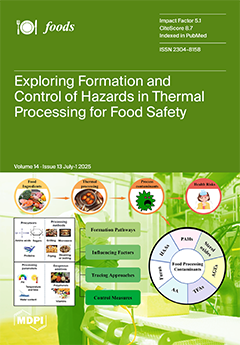Schefflera oleifera honey (SH) is produced from the nectar of
S. Oleifera by worker bees. Due to its unique properties and potential biological activities, this winter honey has attracted much attention. In this study, the physicochemical characteristics, antioxidant and antibacterial activities, antitumor effect
[...] Read more.
Schefflera oleifera honey (SH) is produced from the nectar of
S. Oleifera by worker bees. Due to its unique properties and potential biological activities, this winter honey has attracted much attention. In this study, the physicochemical characteristics, antioxidant and antibacterial activities, antitumor effect against HepG2 cells, and its potential mechanisms of SH were systematically evaluated. The results showed that different SH samples differed significantly in their physicochemical characteristics. The 910 chemical components, including 52 kinds of phenols, phenolic acids, and flavonoids, were detected in the methanol extract of SH using UHPLC-MS/MS by non-targeted metabolomics. Based on our limited knowledge, solanine and soyasaponin I are the first determined components in honey, and they may be used as characteristic substances of SH for identification and adulteration. SH had a weaker inhibitory effect against
Salmonella typhimurium and
Staphylococcus aureus than MH (UMF 10+), analyzed by MBC and MIC assays. Network pharmacology analysis showed that 95 overlapping targets were found between the active ingredients of SH and liver cancer cells (HepG2), which were enriched in KEGG of the PI3K-Akt pathway, Lipid and atherosclerosis, Proteoglycans in cancer, etc. The IC
50 of SH against HepG2 cells was 5.07% (dw/v), which is lower than the glucose, fructose, and sucrose contents in SH on HepG2 cells, of 16.24%, 9.60% dw/v, and 9.94% dw/v, respectively. SH significantly down-regulated the expression of EGFR, AKT1, and SRC in HepG2 cells (
p < 0.05), determined by an enzyme-linked immunosorbent assay kit, and induced cell cycle arrest and apoptosis by multiple pathways. These results provide a theoretical basis for its potential application in developing functional foods and additives.
Full article






